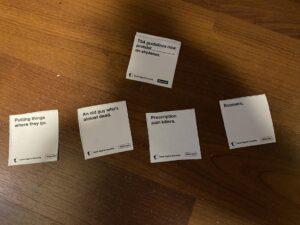In this critical play, I will be analyzing gameplay for Card Against Humanity, a judging game created by Josh Dillon, Daniel Dranove, Eli Halpern, Ben Hantoot, David Munk, David Pinsof, Max Temkin, Eliot Weinstein. The game is primarily played via a deck of cards, but an online version of the game is also available. The game is mainly targeted towards adults, as seen by the wording on the packaging as well as the many sexual, political, and social references found in the cards of the game.
Cards Against Humanity is best played with 6 – 8 players, with players competing in a mainly player vs. player dynamic. The objective of the game for each player is to provide the most “funny” responses to the prompts dished out by the game, as judged by whichever player is currently designated as the round’s judge. Each round, the players have a set of cards in their, which they can use to respond to a prompt card as pulled out from the deck of prompt cards. A player is also designated as the round’s judge, and has to determine which response to the prompt they find to be funniest. The player that then wins the round gains a point, and the judge moves on to another player for the next round. The subjective nature of the game’s rules mean that players will end up finding the most success if they make jokes that best suit the judge’s sense of humor, adding an additional level of complexity to the game.
The primary modes of fun through this game are competition and expression. Players compete with each other and collect prompt cards as trophies, like Thanos collects the infinity stones. These cards serve as very tangible prizes for player success. Players are also able to express their unique senses of humor through the jokes they craft as responses to the prompt cards. Cards Against Humanity is a very fun and engaging game as it allows for players to compete with each other through a form of creative expression so universal to humans across the world: telling jokes.
At some points in the game, players are presented with a very challenging hand with with to make jokes. This game could be improved perhaps, if players could flush out their hand, by completely replacing it with randomly selected cards from the deck.
While the game is aimed at adult audiences, there are also several expansion packs as well as a more family friendly edition, which all take the game’s effective game mechanics and make them more accessible to other audiences. For the game to be most successful however, players need to be comfortable with each other enough, to know that the jokes that are being made are only in jest and not to be taken seriously. This a barrier of familiarity and comfort that is placed at a different level for every individual, and as such, it is important that this is acknowledged and accurately determined for all players whenever the game is played.
The main distinguishing factor between Cards Against Humanity and other games in the genre is the adult-oriented dark humor that presents itself through the cards. The actual gameplay mechanics of the game are very similar to Apples to Apples, but the jokes and card contents are not particularly child friendly.




